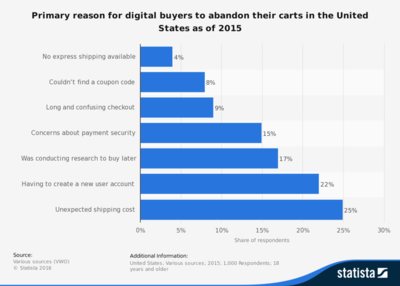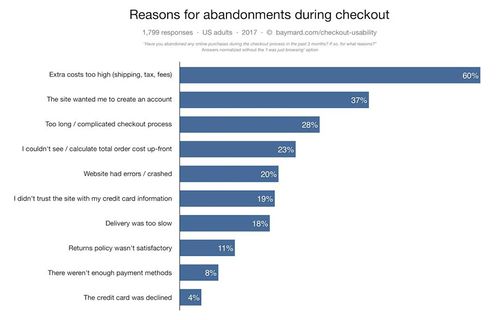Difference between revisions of "Abandonment"
m |
m |
||
| Line 1: | Line 1: | ||
| − | Abandonment is an | + | Abandonment is an [[E-Commerce]] term that refers to a situation when a visitor accesses a [[website]] but terminates any actions by leaving the page. The abandoned activities the Web host desires may include purchasing a product or service, or completing an online survey. Online retailers lose profit when potential customers fail to follow through on a transaction. Abandonment may also be referred to as shopping cart abandonment.<ref>Defining Abandonment [https://www.techopedia.com/definition/1387/abandonment Techopedia]</ref> |
'''Reasons for Shopping Cart Abandonment''' | '''Reasons for Shopping Cart Abandonment''' | ||
| Line 17: | Line 17: | ||
*Organizational use of cart | *Organizational use of cart | ||
**Users often abandonment not because of dissatisfaction but as an organizational method. Even abandoned carts serve as a source of useful information for both consumers and retailers. Retailers can collect interest info of shopper's and use that information to better present purchases and improve throughput in the future. | **Users often abandonment not because of dissatisfaction but as an organizational method. Even abandoned carts serve as a source of useful information for both consumers and retailers. Retailers can collect interest info of shopper's and use that information to better present purchases and improve throughput in the future. | ||
| − | *Entertainment | + | *Entertainment Value |
| − | **Consumers who use carts for fun or to alleviate boredom may still spread positive words about the online | + | **Consumers who use carts for fun or to alleviate boredom may still spread positive words about the online retailer and their experience, despite not completing the purchase. |
| − | *Concerns about | + | *Concerns about price and overall cost |
**Concerns about cost may not necessarily equate a lost sale, but rather an opportunity to make the sale in the future by offering a discount reminder whenever possible. A flat shipping rate may also positively influence the throughput versus a variable rate. Users will be more inclined to purchase more in one sitting as they no longer fear the need to pay excessive shipping.<ref>Implications of Cart Abandonment [https://en.wikipedia.org/wiki/Abandonment_rate Wikipedia]</ref> | **Concerns about cost may not necessarily equate a lost sale, but rather an opportunity to make the sale in the future by offering a discount reminder whenever possible. A flat shipping rate may also positively influence the throughput versus a variable rate. Users will be more inclined to purchase more in one sitting as they no longer fear the need to pay excessive shipping.<ref>Implications of Cart Abandonment [https://en.wikipedia.org/wiki/Abandonment_rate Wikipedia]</ref> | ||
| + | |||
| + | |||
| + | |||
| + | ==See Also== | ||
| + | *[[E-Business]] | ||
| + | *[[E-Strategy]] | ||
| + | *[[Business Value]] | ||
| + | |||
| + | |||
| + | |||
| + | |||
| + | |||
Latest revision as of 21:17, 29 November 2022
Abandonment is an E-Commerce term that refers to a situation when a visitor accesses a website but terminates any actions by leaving the page. The abandoned activities the Web host desires may include purchasing a product or service, or completing an online survey. Online retailers lose profit when potential customers fail to follow through on a transaction. Abandonment may also be referred to as shopping cart abandonment.[1]
Reasons for Shopping Cart Abandonment Cart abandonment is a problem. The average eCommerce store loses over 75% of its sales to cart abandonment. Some industries experience average cart abandonment as high as 83.6%. Given that cart abandonment is such a problem, it is no surprise that there have been countless studies as to why visitors add items to their cart just to leave your site without making a purchase. Two of the most cited resources are below.

Source: Barilliance

Source: Barilliance
Implications
As a result, there are some implications that can be applied to online retails.
- Organizational use of cart
- Users often abandonment not because of dissatisfaction but as an organizational method. Even abandoned carts serve as a source of useful information for both consumers and retailers. Retailers can collect interest info of shopper's and use that information to better present purchases and improve throughput in the future.
- Entertainment Value
- Consumers who use carts for fun or to alleviate boredom may still spread positive words about the online retailer and their experience, despite not completing the purchase.
- Concerns about price and overall cost
- Concerns about cost may not necessarily equate a lost sale, but rather an opportunity to make the sale in the future by offering a discount reminder whenever possible. A flat shipping rate may also positively influence the throughput versus a variable rate. Users will be more inclined to purchase more in one sitting as they no longer fear the need to pay excessive shipping.[2]
See Also
References
- ↑ Defining Abandonment Techopedia
- ↑ Implications of Cart Abandonment Wikipedia
Further Reading
- What Is Shopping Cart Abandonment? Optipedia
- 13 Ways to Combat Shopping Cart Abandonment Dan Shewan
- Why online shoppers abandon their baskets and how to stop them Econsultancy
- Why Cart Abandonment Rates Aren't Falling Forbes
- 40 Cart Abandonment Rate Statistics Baymard
